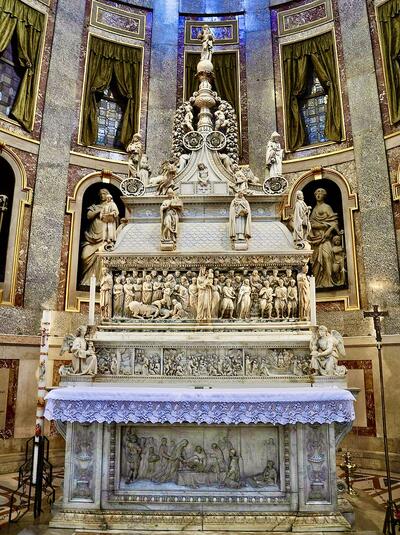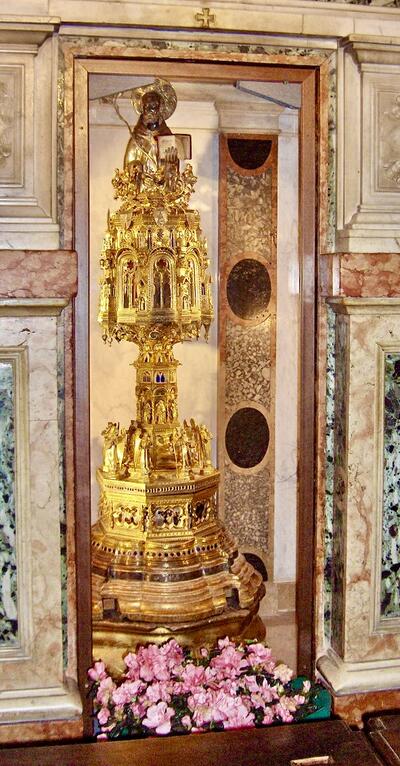Perfumed by Grace: St. Dominic and the Promise of Resurrection
The Feast of the Translation of St. Dominic
May 24
There is no way of telling people that they are all walking around shining like the sun.
This is how the Trappist monk Thomas Merton described a revelation he had one day at the corner of Fourth and Walnut in Louisville, Kentucky. He continued: "I have the immense joy of being a man, a member of a race in which God Himself became incarnate. As if the sorrows and stupidities of the human condition could overwhelm me, now I realize what we all are. And if only everybody could realize this!"
Sometimes we forget that in the scheme of the whole cosmos, as tiny as we are, each hair on our head matters to the God who looks on all creation with love. We are part of the creation that God has made and is remaking anew.
On May 24, we celebrate the Translation of St. Dominic, a feast that invites us to draw a connection between our God who made us out of love and the destiny of our resurrected bodies. The word translation here refers not to words from different languages but to the moving of sacred relics such as the bodily remains of a saint or items that have touched the remains of a saint, from one place to another. In 1233, nearly twelve years after his death and during which time word of Dominic’s sanctity had spread, Dominic’s relics were moved from a simple grave at the church of St. Nicholas of the Vineyards in Bologna, Italy, to a marble sepulcher that was seen as more appropriate.
According to accounts of the day, hundreds of people gathered to witness the event with joy, devotion, and curiosity. At first, the Dominicans worried that Dominic’s body may have decayed, provoking disgust instead of devotion from pilgrims and onlookers. Instead, something miraculous had happened. Blessed Jordan of Saxony, the second Master of the Order after St. Dominic, wrote:
As soon as the stone was taken away a wonderful odor poured out from the opening and its fragrance caused astonishment among those present. They were amazed and overcome with wonder at this strange event. Everyone shed tears and feelings of joy, of fear, and of hope rose in all hearts….
The body was carried to the marble sepulcher where it would rest—it and the perfume that it poured forth. This marvelous aroma which the holy body emitted was was evidence to all how much the saint had truly been the good odor of Christ.”
Miracles, whenever they happen, are meant to strengthen faith. Knowing that, we may look at miracles surrounding relics in several ways. First, they serve as evidence of a saint’s holiness. The Church sees them as such, as does Bl. Jordan. Miracles surrounding relics also serve as a sign of what will come at the final resurrection, when the glorified bodies of the saints will be truly marvelous. Even when only the bones of St. Dominic remained, this miraculous happening points to the “resurrection of the dead, and the life of the world to come,” as the Nicene Creed says.
When treated reverently, devotions surrounding relics can attest to a triad of connected teachings about the body. First, they indicate that God made us, body and soul, out of love and for love. Christ also redeemed our bodies, not just our souls. Second, because of this dignity, after death we must treat any bodily remains with care. Finally, relics and related miracles point us toward the glory of the final resurrection of the dead and eternal life.
Revealing this trio of connectedness, for centuries Dominicans celebrated the Feast of the Translation of St. Dominic rather than the date of his death, August 6, which coincided with the date when the Church celebrated the Transfiguration.
At the Transfiguration, when Jesus took Peter, James, and John to Mt. Tabor, something miraculous happened: Jesus was transformed before their eyes, his clothes looked dazzlingly white, and Moses and Elijah appeared on either side of him. Peter, James, and John heard the voice of the Father out of the cloud: “This is my beloved Son, with whom I am well pleased, listen to him.”
All creation is in the process of being transfigured, if only we could see it! When the Father glorifies Jesus and shows us the way toward him, or the bodies of the saints point towards eternity in miraculous ways, or we notice the people around us “shining like the sun” as Thomas Merton did, we see a fundamental truth. As author Daniel Nayeri wrote, “But like you, I was made carefully, by a God who loved what He saw.”
Reality is being redeemed and remade, right down to our very bones and before our eyes. That very reality proclaims that we too, God willing, will one day be transfigured, dazzlingly different, and transformed. Until then, God gives signs of the glories to come through saints such as St. Dominic.
Hope Zelmer
Hope Zelmer is a writer and a former theology teacher and campus minister at Fenwick High School, a Dominican Catholic preparatory school in Oak Park, Illinois. Hope has written for publications such as FaithND, Church Life Journal, and FemCatholic. She holds a BA and MA in Theology from the University of Notre Dame.



